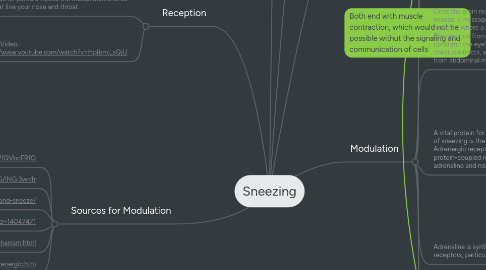
1. Reception
1.1. Sneezing is triggered when dust, dirt or another particle tickles the mucus membranes that line your nose and throat.
1.1.1. The stimuli is received Inside the nose and nasal mucosa.
1.1.1.1. The receptor Histamine H1 is responsible for recognizing the behaviors stimuli. While awake the nose hairs catch debris and sends signals to the brain to get them out.
1.1.1.1.1. When dust gets in your nose the nose realizes this and wants to remove it the only way how is by a strong force. The brain receives the signal to sneeze triggered from the nose and the releases a strong sneeze which cleans everything out of one's nose.
1.2. Link to Video: https://www.youtube.com/watch?v=HpIbmj_sQjU
2. Sources for Modulation
2.1. http://scienceline.org/2008/01/ask-hadhazy-sneeze/?_sm_byp=iVVKVnWfQVbcFRfQ
2.2. https://targetexplorer.ingenuity.com/gene/ING/ING:3wn1r
2.3. http://medchrome.com/basic-science/physiology/mechanism-of-cough-and-sneeze/
2.4. http://www.nature.com/scitable/topicpage/gpcr-14047471
2.5. http://www.healthhype.com/sneeze-reflex-process-and-mechanism.html
2.6. http://www.physiologymodels.info/ans/adrenergic.htm
3. Effects
3.1. make a sudden involuntary expulsion of air from the nose and mouth due to irritation of one's nostrils.
3.1.1. Link to Video: https://www.youtube.com/watch?v=Bbsx6I2a5uU&feature=youtu.be
3.2. Neuromuscular Junction-A neuromuscular junction (or myoneural junction) is a chemical synapse formed by the contact between a motor neuron and a muscle fiber. It is at the neuromuscular junction that a motor neuron is able to transmit a signal to the muscle fiber, causing muscle contraction.
3.2.1. Neuromuscular Junction
3.3. Acetylchoine, (ACh)
4. Modulation
4.1. The receptors--nerve endings in your nasal pathways--detect a certain irritation caused by dust, a certain smell, etc. The irritation impulse goes to the sneezing center in your brain stream.
4.2. The sneezing center--located in the lower brain stem--receives the initial signal from the nerve receptors.
4.2.1. Brain Stem
4.3. Once the brain receives the signal from the sneeze, a message is sent to the body’s muscles, where a major contraction takes place. The reaction from the brain usually remains constant: the eye’s close, facial muscles react, chest contracts, and forced movement happens from abdominal muscles.
4.3.1. Link to picture: http://jrs.sagepub.com/content/101/12/587/F1.large.jpg
4.4. A vital protein for the modulation and relaying of sneezing is the adrenergic receptor. Adrenergic receptors are a type of G protein-coupled receptors that target adrenaline and noradrenaline.
4.4.1. G-protein-coupled-receptors (GPCR) vary greatly and are present in eukaryotic cells. These type of proteins work like a mailing operation--they receive messages from light, sugar, and lipids, and inform other cells about the sustainability of light and nutrients in their particular environment. GPCR's respond to a variety of outside signals and are important to many human functions, such as sneezing.
4.4.2. Comment: The adrenergic receptors can be broken down into two types--alpha and beta. Both alpha and beta have several sub types. Both hold a preference on which one they rather prefer--adrenaline or noradrenaline.
4.5. Adrenaline is synthesized by the adrenergic receptors, particularly the ADRB genes.
4.5.1. Comment: Adrenaline or epinephrine is a hormone that causes one who is feeling strong emotion to increase their heart rate, breathing, and ultimately, give them more energy.
4.6. Many cells carry the ADRB gene. This particular gene is found in the medulla of the brain.
4.6.1. Comment: ADRB stands for adrenergic receptor beta. There are multiple types of this gene in which the have sub types numbering up to 3.
4.7. The modulation of sneezing is finished by the activation of the pharyngeal, tracheal, and respiratory muscles.
4.7.1. Link to picture: https://rubred.files.wordpress.com/2013/04/nkjf.jpg

